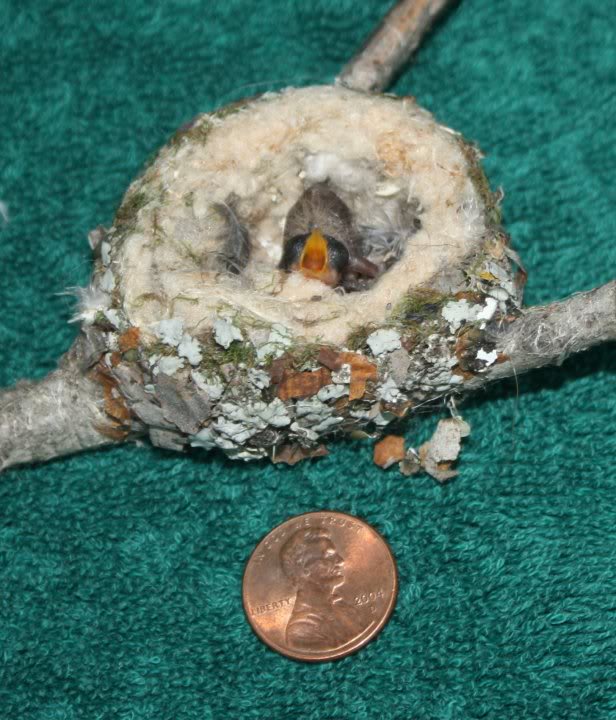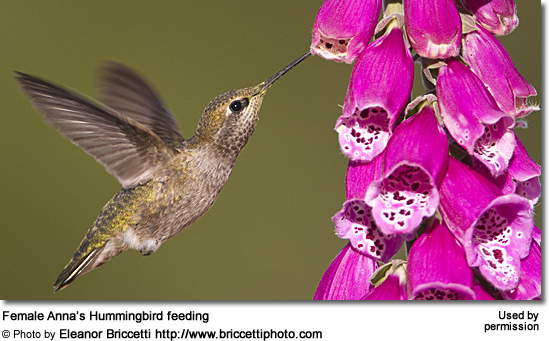Reproduction
Like most species of birds, Calypte anna males perform a
special mating ritual. However, what sets them apart from
other birds is the extreme at which they go to in order to
impress a potential mate. The males will climb to heights
as high as 35 meters in the air and dive towards the ground (and
the watching female), reaching speeds close to 100 km/h, where
they will then let out a screech by whipping wind through its’
tail (Clark 2009). This clearly is pushing these small
birds to their flight limits as they often perch between dives
panting heavily (Clark 2009). However challenging these
dives may be, there is relatively low energetic cost to them
(Clark 2009). If the male finds a receptive female, he
then follows her towards the nest site and continues to perform
a shuttle display (The Cornell Lab of Ornithology 2011).
During this part of the courtship ritual, the male swings back
and forth above the female singing an intense song (The Cornell
Lab of Ornithology 2011).
Calypte anna males perform these courtship dives in their
own marked and established breeding territories. A
breeding territory for C. anna males measure about 4 to 6
hectares (Stiles 1971). Males seem to choose these
territories based on the distribution of flowers as well as
other factors (Stiles 1971). Breeding territories are
highly defended by males, often embarking on long chases in
defense of their territory (Stiles 1971). These
territories are therefore very energetically costly to defend
and maintain (Stiles 1971).
Though the courtship dive performed by the male is the flashiest
part of the reproductive process, there is much more that goes
into reproductive success. During the breeding season
males and females both breed with multiple mates, not forming
pairs with any individual (The Cornell Lab of Ornithology 2011).
Females are the sole caretakers of the offspring (The Cornell
Lab of Ornithology 2011). The nest, taking about a week to
construct, is made out of plant down, spider webs, cattail,
willow, leaves, thistle, and/or small feathers (The Cornell Lab
of Ornithology 2011). The nest measures at about 1 inch
tall and 1.5 inches wide (The Cornell Lab of Ornithology 2011).
Occasionally the female will decorate with lichen or mosses on
the outside of the nest (The Cornell Lab of Ornithology 2011).
The nest is usually a horizontal branch placed 6-20 feet off of
the ground and close to a source of nectar. Trees commonly
inhabited by Calypte anna include oak, sycamore, and eucalyptus
trees. Females typically lay 2 eggs at a time, which have
an incubation period of 16 days (The Cornell Lab of Ornithology
2011). The female cares for and feeds the hatchlings until
they become independent at about 18-23 days (BirdWeb).
 The females will scavenge for nectar and insects when feeding
her young (Carpenter and Castronova 1980). It has been
discovered that Calypte anna females will change their feeding
diets according to food source availability. At the
beginning of the day, the female is likely to feed her young
nectar for it is in abundance and the insects are not active at
this time of day (Carpenter and Castronova 1980). However,
as the day progresses the diet changes from nectar dominant to
insect dominant even though the flower’s nectar production
remains relatively constant during the entire day (Carpenter and
Castronova 1980). This suggests that the female is
choosing to feed insects, possibly due to a higher protein
composition (Carpenter and Castronova 1980). It is
believed that nectar fed in the morning gives the offspring the
energy they need to rebound from energy loss throughout the
night (Carpenter and Castronova 1980). The switch to
protein in the late afternoon is believed to give the young the
protein they need for growth (Carpenter and Castronova 1980).
These feeding habits have been selected for because it is what
gives the offspring the most reproductive success.
The females will scavenge for nectar and insects when feeding
her young (Carpenter and Castronova 1980). It has been
discovered that Calypte anna females will change their feeding
diets according to food source availability. At the
beginning of the day, the female is likely to feed her young
nectar for it is in abundance and the insects are not active at
this time of day (Carpenter and Castronova 1980). However,
as the day progresses the diet changes from nectar dominant to
insect dominant even though the flower’s nectar production
remains relatively constant during the entire day (Carpenter and
Castronova 1980). This suggests that the female is
choosing to feed insects, possibly due to a higher protein
composition (Carpenter and Castronova 1980). It is
believed that nectar fed in the morning gives the offspring the
energy they need to rebound from energy loss throughout the
night (Carpenter and Castronova 1980). The switch to
protein in the late afternoon is believed to give the young the
protein they need for growth (Carpenter and Castronova 1980).
These feeding habits have been selected for because it is what
gives the offspring the most reproductive success.
Return to Home Page Go to Interactions!
Page created by Kristine Kumferman
